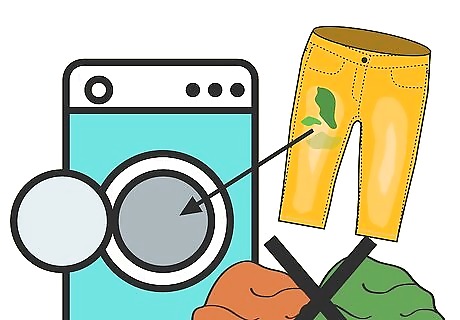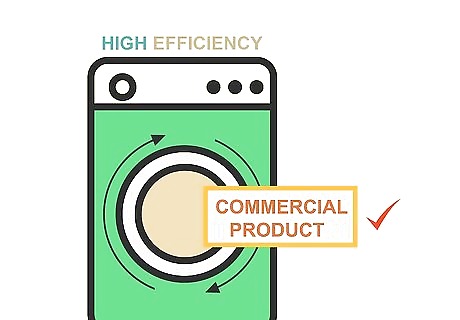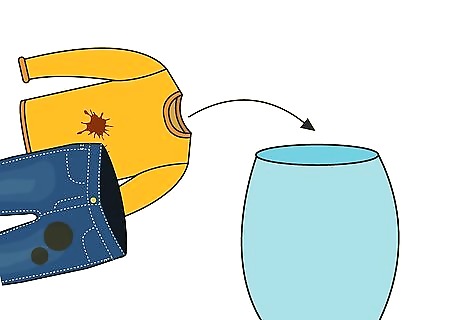
views
Using a Washing Machine

Don’t wash contaminated clothing with uncontaminated items. Just to be safe, wash your contaminated items on their own without any uncontaminated clothes. The laundry cycle should remove the oil from your clothing, but you won’t want to risk contaminating other items. Traces of oil could remain in the leftover water that didn't drain. Further, agitation is necessary to remove the oil from your clothing, and extra clothes will result in less agitation.

Use the hottest water, largest load, and longest cycle settings. Lots of hot water, agitation, and plenty of washing time are all it takes to remove urushiol from clothing. It might seem wasteful to wash just a few items on the highest load and time settings, but using these settings is essential. Urushiol isn't very water soluble, so it’ll take lots of water and detergent to get rid of it. In addition, a long wash cycle will help prevent residue from redepositing on your clothing and washing machine’s interior.

Use a full scoop of laundry detergent. Because of urushiol’s low solubility, you’ll need as much detergent as possible to get it out of your clothes. Use an entire capful or scoop of detergent, or pour it into your washer’s detergent drawer compartment to the max fill line. While any laundry detergent should do the trick, a degreaser detergent is the best option.

Avoid filling up the washing machine with clothing. If necessary, divide your clothes into multiple loads so each load only fills your washer halfway at most. If you completely fill your washing machine with clothes, there won’t be enough room for the agitation necessary to remove the oil from your clothes.

Wear gloves when you transfer clothes to the dryer. If you used a long washing cycle, you’ve most likely eliminated all of the oil. However, there’s a chance that traces of the oil might be left in the water in the machine that didn’t drain after the wash cycle, and you don’t want to take any chances of getting it on your skin. Once you’ve transferred the clothes, run the empty washer for one cycle on the hottest setting to ensure you’ve removed any residual oil. Feel free to air dry your clothes if you prefer. The washing machine does the dirty work; a machine dryer doesn’t play any part in getting rid of the oil.

Use a commercial product if you have a high efficiency washer. A high efficiency washing machine automatically senses load size and uses less water, so it might not get out all of the oil in your clothes. To stay on the safe side, pre-treat your clothes with a store-bought urushiol removal product, such as Tecnu or Zanfel, then machine wash them twice. While wearing gloves, apply the product to your clothes when they're dry. After washing them, run the empty washer on a hot self-cleaning cycle.
Hand-Washing Clothing and Gear

Clean non-machine washable items with hot water and detergent. Wear long rubber gloves when hand-washing an item that can’t go in the washer, like a leather jacket or shoes. Mix two tablespoons of laundry or dish detergent with two cups (480 mL) of hot water. Soak a sponge with the cleaning solution, wash the item’s surface, then wipe away soapy residue with a wet cloth. You can use a toothbrush to scrub hard to reach places. Just remember to throw out the toothbrush and sponge when you’re finished. To clean shoelaces, remove them and soak them in the cleaning solution, then rinse them under hot water. Check your item’s care instructions and test any cleaning solution on an inconspicuous area before washing the entire item.

Try using a commercial product on leather. If you’re concerned about using detergent on leather garments or shoes, you can try applying a commercial urushiol removal product. Saturate a dry cloth with the product, rub it onto the item, then wipe it away with a wet cloth. Check your product’s label or website to verify it’s safe for leather, and test it on an inconspicuous area first.

Wash tools and gear with rubbing alcohol or detergent. Don’t forget to wash garden tools, golf clubs, jewelry, and any other exposed items. Rinsing them with rubbing alcohol will do the trick. If you don’t have any handy, or are concerned about how alcohol might effect an object, wash it with dish or laundry detergent and hot water.

Take your clothing to a dry cleaner if necessary. If you have any doubts about hand-washing a delicate item, it’s best to leave it to the professionals. Dry cleaners use chemicals that aren’t water-based, so if your garment can’t handle any water exposure, a professional can remove urushiol without damaging it. Be sure to keep your clothing in a plastic bag, and let your dry cleaner know that the items were exposed to poison ivy.
Preventing Cross Contamination

Wear gloves when handling contaminated clothes and gear. Vinyl or rubber gloves are best, as urushiol can penetrate latex. Preferably, your impermeable gloves should cover your forearms. For extra protection, wear long sleeves to protect your arms. Throw out your gloves after handling contaminated items, even if they’re rubber kitchen gloves.

Store items in a plastic bag until you can wash them. Wash your clothes as soon as possible to prevent urushiol from setting and becoming more difficult to remove. If you can’t wash them immediately, store contaminated clothing and gear in a plastic garbage bag. Throw out the bag after you take the clothes out to wash them. Avoid letting contaminated items come into contact with clothes that haven’t been exposed to poison ivy or poison oak.

Clean your washing machine, sink, or basin after washing your clothes. After machine washing your clothing, run the empty washer for one cycle with a cup of bleach and hot water. If you used a sink, bucket, or basin to wash items by hand, thoroughly clean it with a sponge or cloth, hot water, and dish detergent. Rubbing alcohol or diluted bleach can be substituted for dish detergent. It’s best to just throw away sponges, brushes, or other tools you used to wash items by hand.




















Comments
0 comment